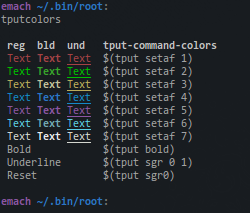An old article by Todd Partridge (Gently) but still really useful if you are writing some bash scripts and want them more readable with some colors:
Users who have been using Linux for awhile often learn that creating a basic script is a good way to run multiple, often-repeated commands. Adding a little color to scripts can additionally provide nice feedback. This can be done in a fairly straight-forward way by using the tput command.
A common way of doing this is to define the colors that tput can produce by putting them at the beginning of the bash script:
#!/bin/bash # scriptname - description of script # Text color variables txtund=$(tput sgr 0 1) # Underline txtbld=$(tput bold) # Bold bldred=${txtbld}$(tput setaf 1) # red bldblu=${txtbld}$(tput setaf 4) # blue bldwht=${txtbld}$(tput setaf 7) # white txtrst=$(tput sgr0) # Reset info=${bldwht}*${txtrst} # Feedback pass=${bldblu}*${txtrst} warn=${bldred}*${txtrst} ques=${bldblu}?${txtrst} |
When writing new scripts using templates with these variables already defined can quicken the creation process and help keep scripts organized
If just needing to use tput colors for specific instances this script can display the tput definitions and their corresponding possibilities:
#!/bin/bash # tputcolors echo echo -e "$(tput bold) reg bld und tput-command-colors$(tput sgr0)" for i in $(seq 1 7); do echo " $(tput setaf $i)Text$(tput sgr0) $(tput bold)$(tput setaf $i)Text$(tput sgr0) $(tput sgr 0 1)$(tput setaf $i)Text$(tput sgr0) \$(tput setaf $i)" done echo ' Bold $(tput bold)' echo ' Underline $(tput sgr 0 1)' echo ' Reset $(tput sgr0)' echo |
You should get an output similar to this one:
Popular Posts:
- None Found

